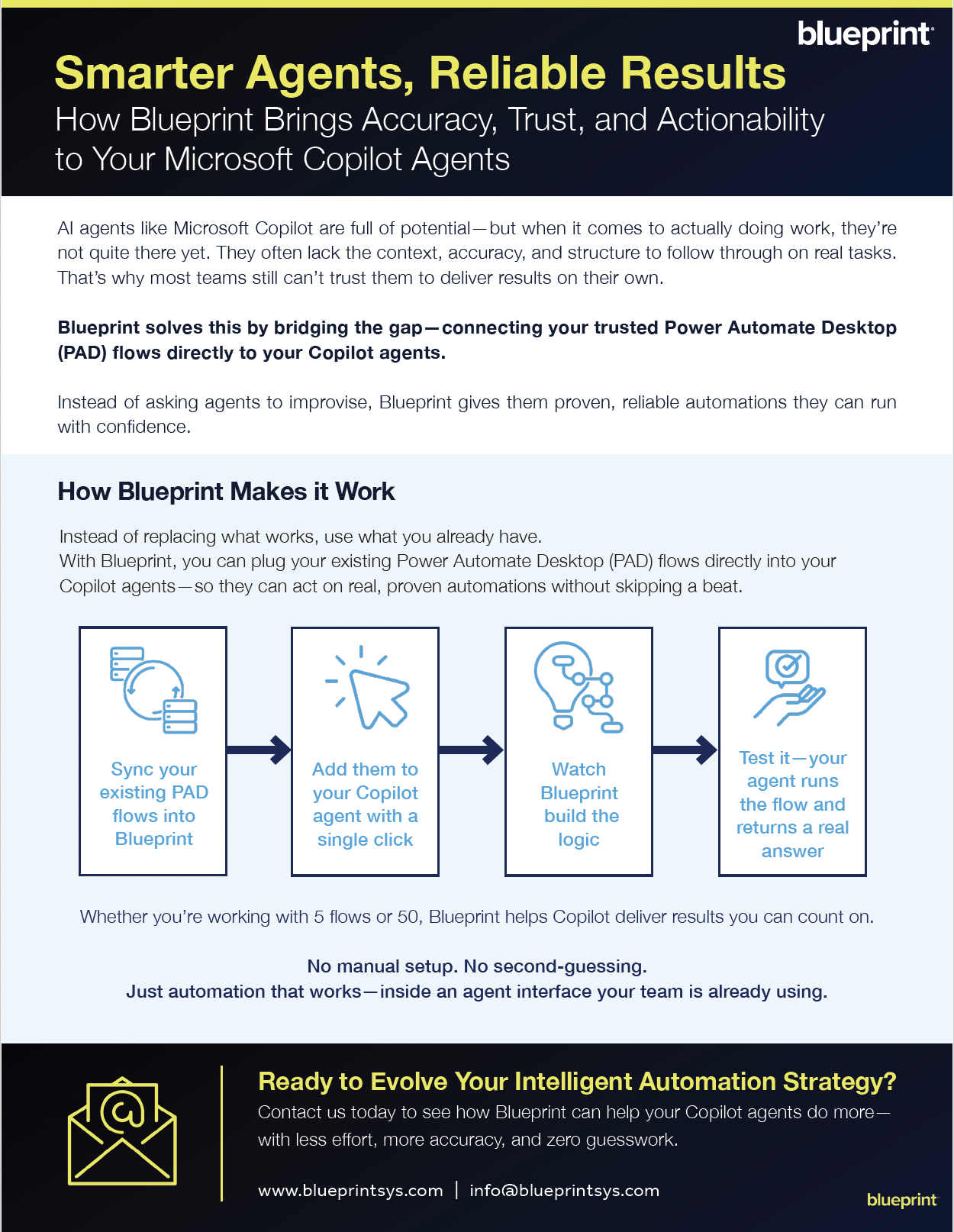Blueprint Resource Library
Kickstart your digital transformation with our most helpful RPA resources which includes infographics, videos, and more!
Filter Resources

Featured
Process Governance & Compliance
Most Recent
Smarter, Faster, Riskier? Rethinking Automation in the Age of Agentic AI
Most Recent
Datasheets
Datasheets
Read Now
Technical Overview: Blueprint RPA Migration Solution
Datasheets
Read Now
Blueprint + Blue Prism Integration Datasheet
Datasheets
Read Now
RPA Platform Migration Datasheet
Datasheets
Read Now
Blueprint Platform Datasheet
Datasheets
Read Now
Replatform from Automation Anywhere to Microsoft Power Automate
Datasheets
Read Now
Replatform from Blue Prism to Microsoft Power Automate
Datasheets
Read Now
Blueprint Process Analysis: Understand your Processes, Improve your Business
Datasheets
Read Now
Blueprint RPA Analytics
Datasheets
Read Now
Value Map Assessment ROI Brochure
Datasheets
Read Now
Automation Re-platforming ROI Brochure
Datasheets
Read Now
Migrate to Microsoft Power Automate with Blueprint
Datasheets
Read Now
Blueprint Assess Datasheet
Datasheets
Read Now
Smarter Agents, Reliable Results: How Blueprint Brings Accuracy, Trust, and Actionability to Your Microsoft Copilot Agents
Infographics
Infographics
Read Now
RPA Migrations in 2023 Research Report - Top 5 Stats
Infographics
Read Now
RPA Glossary
Infographics
Read Now
6 Considerations for When to Use RPA in Finance and Accounting
Infographics
Read Now
Benefits of Automation Re-Platforming with Blueprint
Infographics
Read Now
How much does Robotic Process Automation (RPA) Really Cost?
Infographics
Read Now
10 Metrics You Should be Tracking to Drive RPA Success
Infographics
Read Now
6 Easy Steps for Implementing Enterprise Business Process Analysis (EBPA)
Infographics
Read Now
Five Business Process Analysis (BPA) Techniques You Should Know
Infographics
Read Now
Nine Principles of Continuous Process Improvement
Infographics
Read Now
10 Reasons Microsoft Power Automate is the Right Move for You
Infographics
Read Now
4 Ways Microsoft Power Automate Solves 4 Automation Challenges
Product Demos
Product Demos
Watch Now
RPA Migration - Automation Anywhere to Power Automate Product Demo
Product Demos
Watch Now
RPA Platform Migration: How Blueprint Makes RPA Migration Possible
Product Demos
Watch Now
How to Analyze Business Processes, Identify Inefficiencies, and Drive Continuous Improvement
Product Demos
Watch Now
RPA Migration - Blue Prism to Power Automate Product Demo
Product Demos
Watch Now
RPA Migration - Automation Anywhere to Power Automate Product Demo
Product Demos
Watch Now
RPA Migration - UiPath to Power Automate Product Demo
Product Demos
Watch Now
Blueprint's RPA Analytics
Videos
Videos
Watch Now
Scale RPA Enterprise-Wide with Digital Blueprints - Explainer Video
Videos
Watch Now
Blueprint for Enterprise Process Automation - Explainer Video
Videos
Watch Now
Accelerate Automation Replatforming with Blueprint - Explainer Video
Videos
Watch Now
Rapid Transformation: Migrating to Power Automate with Blueprint
Whitepapers/eBooks
Whitepapers/eBooks
Read Now
The Business Case for Migrating Your RPA Estate to Microsoft Power Automate
Whitepapers/eBooks
Read Now
RPA Migration in 2023 - Research Report
Whitepapers/eBooks
Read Now
RPA Migration Best Practices
Whitepapers/eBooks
Read Now
The State of RPA in 2023 - Research Report
Whitepapers/eBooks
Read Now
2024 RPA Predictions
Whitepapers/eBooks
Read Now
AI (Artificial Intelligence) in RPA
Whitepapers/eBooks
Read Now
Best Practices for Small RPA Migrations
Whitepapers/eBooks
Read Now
RPA Migration Checklist
Whitepapers/eBooks
Read Now
7 Ways to Optimize RPA Governance and Maximize ROI
Whitepapers/eBooks
Read Now
Understanding RPA's Total Cost of Ownership (TCO) and How to Lower It
Whitepapers/eBooks
Read Now
RPA Process Assessment and Candidate Checklist
Whitepapers/eBooks
Read Now
How to Measure a Successful RPA Platform Migration
Whitepapers/eBooks
Read Now
Embracing Process Excellence - Whitepaper
Whitepapers/eBooks
Read Now
Process Modernization in 2022 - Research Report
Whitepapers/eBooks
Read Now
Process Improvement Checklist
Whitepapers/eBooks
Read Now
Cloud Automation vs On-Premises: Which Should you Choose?
Whitepapers/eBooks
Read Now
Automation Anywhere and Blueprint
Whitepapers/eBooks
Read Now
Digital Twins Whitepaper
Whitepapers/eBooks
Read Now
Intelligent Automation & RPA: 2022 Trends and Predictions for 2023
Whitepapers/eBooks
Read Now
A Guide to RPA Migration
Whitepapers/eBooks
Read Now
AI in RPA
Whitepapers/eBooks
Read Now
Automation Sprawl
Whitepapers/eBooks
Read Now
Automation Security
Whitepapers/eBooks
Read Now
Future-Proofing Automation Compliance
Templates
Templates
Read Now
Improve Your RPA Center of Excellence (CoE) - Cheat Sheet
Templates
Read Now
A Template to Setting Up an RPA Center of Excellence (CoE)
Templates
Read Now
To-do List for Scaling Robotic Process Automation
Templates
Read Now
Process Decomposition Template
Most Recent
Most Recent
Read Now
Automation Audit Checklist
Learning Centers
Learning Centers
Read Now
How to Implement RPA Enterprise-Wide
Learning Centers
Read Now
Best Practices for Achieving RPA at Scale
Learning Centers
Read Now
What is Robotic Process Automation?
Learning Centers
Read Now
Automation Re-Platforming: Frequently Asked Questions
On Demand Webinars
On Demand Webinars
Watch Now
Who Moved My Bots?! Expert insights on migrating automation programs
On Demand Webinars
Watch Now
The RPA Metrics You Should be Tracking to Drive ROI
On Demand Webinars
Watch Now
Rumble in the Automation Jungle: Manual Migration vs Blueprint's Migration Assistant - What's Better, Faster, & Cheaper?
On Demand Webinars
Watch Now
On-Demand Webinar: Breaking the Cycle of Process Debt
On Demand Webinars
Watch Now
Cut Costs, Not Corners: Mastering a LoCode Digital Strategy and RPA Migration
On Demand Webinars
Watch Now
WEBINAR: Mastering RPA Migration: Strategies for Seamless Transitions and Cost Efficiency
Upcoming Events
Upcoming Events
Watch On-Demand
Fix the Faucet: Stop Automation Cost Leaks Before They Drain Your ROI
Most Recent
Most Recent
Watch On-Demand
Smarter, Faster, Riskier? Rethinking Automation in the Age of Agentic AI
No Items Found


